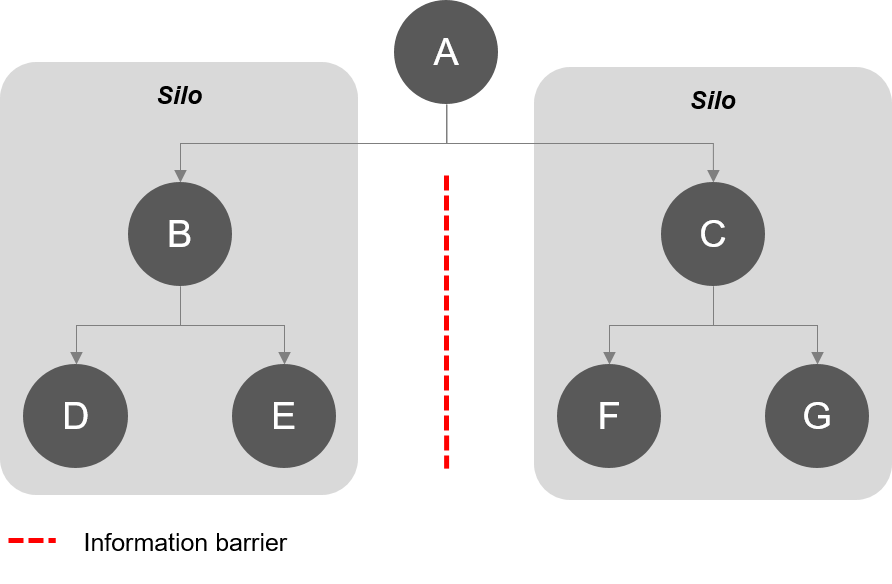
Information silos tend to grow organically in your business, and before you know it none of your teams are talking to each other. This hampers productivity and growth as information is duplicated across the organization and teams are not learning from past mistakes. Instead of collaborating with one another, information is not being shared and it’s hoarded by teams.
Silos are a natural outcome of business practices that tend to cluster expertise into departments broken up into functional groups. Silos only become a problem when each team is focusing on its own goals and objectives to the exclusion of every other team.
There are many reasons why information silos spread within an organization. It could simply be a byproduct of a lack of communication, which is easier to remedy. On the other hand, silo mentality may grow because of internal power struggles, fear of losing one’s job, or organizational inefficiency.

(Source)
It’s best to prevent silos from growing in the first place – now let’s take a look at what information silos are as well as some early warning signs that your organization is suffering from a silo effect.
What are Information Silos?
Information silos (also known as knowledge silos, data silos, or organizational silos) occur when individuals or groups are generating information but they fail to integrate that information for other parts of the business to use in a strategic manner. A business’s employees don’t share knowledge or work collaboratively, resulting in the organization’s failure to respond to market changes in an agile manner.
Information silos can be caused by cultural problems in an organization which causes employees to work competitively rather than collaboratively as well as not having the proper technology stack to allow information to flow freely. Departments don’t communicate effectively, leading to a duplication of effort and wasted time spent searching for information.
Early Warning Signs Your Business Is Suffering From Knowledge Silos
- Mid-to-senior level stakeholders are unaware of important initiatives being carried out by other departments or groups. It’s not always necessary for everyone in a business to be aware of every initiative but in this case, it’s the result of an information silo.
- Departments feel unprepared for hand-offs for projects from other departments. Imagine the marketing team being asked to create content for a product that has been in development for some time – they feel their deadline is too short which could result from an information silo.
- Top-down communication in your organization may flow freely but bottom-up communication is not taking place. A lack of actionable suggestions coming from below management is a sign of an information silo.
If you notice any of these early warning signs, you need to take steps to prevent information silos from taking root in your business.
The Benefits of Breaking Down Organizational Silos

Company executives overwhelmingly agree that good access to information is crucial to improving many aspects of the enterprise – it’s the basis for improved decision-making, saves time and prevents frustration, and prevents duplication of effort.
Improves employee productivity
There are many benefits inherent in breaking down information silos. To start with, you’ll see an increase in productivity overall. According to research by McKinsey, sharing knowledge improves productivity by 35% – currently, employees typically spend 20% of the working week searching for information necessary to their jobs. Breaking down silos can cut the time that employees spend searching and allow them more time to do their job.
Prevents duplication of effort
According to some studies, 90% of the time employees spend creating new reports or products is spent duplicating information that already exists elsewhere in the business. By breaking down information silos, you are enabling employees to find that necessary information and reducing the time spent recreating work that has already been done.
Increases ROI for the organization
Your organization will be more profitable if you break down information silos. Several studies in the past five years point to significant ROI for improved access to information. ROI figures range from 38% to over 600% for enterprise companies.
Improves collaboration and potential for innovation
By breaking down information silos, employees from different departments will have the opportunity to collaborate with each other to produce more innovative products. Your company will be able to work as a cohesive unit instead of different departments battling to meet their own goals and objectives.
Now, let’s move on to the tactics for breaking down information silos.
Use the 5W1H Approach
First of all, making it clear who does exactly what and how they do it is the key to breaking down information silos.
- WHO – Who makes up the departments in your organization? Who is the best person to approach with information requests? What relationships already exist between your own department and the other departments?
- WHAT – Identify what each department does and doesn’t do, so you won’t be wasting time making requests that aren’t relevant. Speak to the other departments about their work and find out how it relates to your own.
- WHY – Find out why each department in the organization exists. This is slightly different from finding out what they do. Learn how each department contributes to the overall mission of the business.
- WHERE – What is the location of each department in your company? It could be in your own office, company headquarters, or in a different location and time zone altogether. This information lets you plan how you will contact other teams, such as scheduling virtual meetings.
- WHEN – When do other departments need to get involved in your work? Understand the company’s operational procedures and guidelines and follow the rules, but also ask other departments for advice and guidance even when not mandated by policy to do so.
- HOW – How does the process work? Consider the specifics of how each department operates and how to approach them. Complete any formalities a department needs in order to deal with a request. Find out how much time other departments need to finish a job, provide supporting information, and fill in the required forms.
Share the Common Vision and Goals for the Company
Help employees understand where they fit into the broader picture of your business by sharing a common vision and goals. This can even prevent the silo mentality from growing in the first place. Not only do individuals understand how they contribute to the big picture but they develop an idea of how other individuals and teams contribute as well.
It’s all about transparent communication as the foundation for an open company culture. If everyone feels involved with what’s happening throughout the company, they are less likely to hold onto information and resources just for themselves.
If you take the initiative to share information about the company, this creates a top-down effect that shows employees how they should be operating. Transparent communication and open company culture can help lead to a culture of knowledge sharing instead of knowledge hoarding.
Key takeaway: With a unified vision top of mind, departmental managers can shift away from their often conflicting departmental goals towards goals that will benefit the entire business.
Bring Teams Together to Encourage Knowledge Sharing and Knowledge Transfer
If teams are working together, they are more likely to share knowledge. You can bring teams together for critical launches with at least one member from each core department involved. These could be engineering, product, marketing, sales, and customer service. Teams working closely together demolishes the silo mentality.
Team members will get to know the important role that each individual and department plays in the project, making it less likely that they will guard information and resources. They will see the importance of sharing information as part of their investment in a common goal.
To encourage continuous knowledge sharing and knowledge transfer, you need to make it easy for your teams to communicate and collaborate with each other. Team chat apps are the ideal way for departments to stay connected and communicate instantly no matter where they are in the world. Team chat apps are more transparent than relying on email and come with the ability to ping certain groups or individuals.
Key takeaway: Teams who work together on shared projects are more likely to collaborate and break down information silos outside of the project.
Implement Company-Wide Employee Training Programs
Without learning about the roles of others in the company, individuals themselves are in danger of becoming silos. Though specialization is important, team members need to understand how their coworkers fit into the larger picture.
Training employees on tasks and skills that aren’t in their official remit is a great way to build that sense of insight into what coworkers are doing all day. The training will teach them when resources or information might be useful to other departments, and encourage them to share.
Training is resource intensive and one way to cut down on costs is by using a Learning Management System (LMS) such as Lessonly or TalentLMS. You can create training modules for your company and once they have been developed, you can keep reusing them for future training.
Key takeaway: Training your employees in areas outside of their specialty increases their understanding of the role their coworkers play in the organization, and encourages them to share information.
Communicate Frequently and Effectively
Silos are an important part of organizational structure and the goal is not to eliminate them completely. The aim is to improve the flow of information between silos so individual employees have the information they need to do their jobs.
Communicate often throughout your business to encourage information sharing. Internal communication is very important and can be managed through internal collaboration tools or a company intranet. Keep your business updated with the latest developments and share important metrics regularly to give an idea of progress.
Key takeaway: Top-down communication will encourage individuals to share their own information with coworkers, as they follow the example set by the company culture.
Implement an Internal Knowledge Base
Having an internal knowledge base is ideal for companies looking to break down their organizational silos and improve on their knowledge management capabilities as it pushes your business to gather, organize, and share employee knowledge.
A knowledge base works in the following way:
- Storing information. Information is not left isolated in someone’s email inbox or in project management software that no one uses anymore. You can easily review the information in your knowledge base and search through documents.
- Sharing information. You can easily control who has access to your knowledge base, right down to the article level. It’s easy to share documents in just a few clicks, and you always know you have the latest version available.
- Maintaining information. You can add and edit information that you have stored in your knowledge base. You can use the analytics to see which articles are being viewed and identify where there may be gaps.
Key takeaway: Each department can have their own internal knowledge base that they keep updated with the latest information. It’s a simple way to share information with other teams and also to control who has access to the knowledge base.
Final Remarks
By breaking down information silos, you will have your departments and teams collaborating, communicating, and exchanging information. It will enhance productivity and result in net gains for your organization as a whole.
It’s important to identify whether silos exist in your company, and if they do then you can take steps to combat silo mentality. Whether that’s enforcing a stronger company culture, aligning everyone’s work towards a shared goal, or sharing a company vision with your employees, there are ways to break down information silos.
Provide employees with the right tools they need to collaborate, whether that’s a team chat app for shared projects, or an internal knowledge base for employees to publish and share information with other teams.




